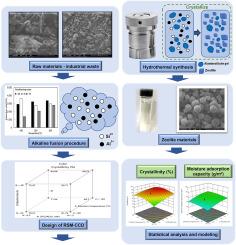Developing ecological-zeolites from industrial waste glass and sandblasting waste for humidity control
IF 6.3
3区 工程技术
Q1 ENGINEERING, CHEMICAL
Journal of the Taiwan Institute of Chemical Engineers
Pub Date : 2025-07-30
DOI:10.1016/j.jtice.2025.106314
引用次数: 0
Abstract
Background
Zeolite materials are widely used for humidity control in industrial settings; however, conventional synthesis methods often lack scalability, efficiency, and environmental sustainability. This study developed an eco-friendly approach to synthesizing high-performance zeolites by repurposing industrial waste materials—LCD waste glass and sandblasting waste—as sources of raw silica and alumina.
Methods
Response surface modeling (RSM) with central composite design (CCD) was employed to optimize SiO2/Al2O3 ratio, reaction temperature, and reaction time to enhance crystallinity, surface morphology, and moisture adsorption. The resulting materials were characterized by X-ray diffraction (XRD), Fourier transform infrared spectroscopy (FTIR), and scanning electron microscopy (SEM), with moisture-adsorption performance evaluated under standard conditions.
Significant Findings
Zeolites synthesized under optimal conditions exhibited a uniform mesoporous network (average pore diameter 12.54 nm), a high specific surface area (81.87 m2/g), and excellent crystallinity (88.23 %). They yielding an impressive adsorption capacity of 79.27 cm3/g STP and moisture uptake of 59.08 g/m2—>50 times greater than conventional methods. Analysis of variance (ANOVA) confirmed the reliability of the model, identifying reaction temperature as the factor with the most pronounced influence on crystallinity and adsorption performance. This study established a sustainable pathway for converting industrial waste into value-added zeolites with superior humidity-control properties, laying the groundwork for green manufacturing of advanced adsorbents across diverse industrial application.

利用工业玻璃废渣和喷砂废渣开发用于湿度控制的生态沸石
沸石材料广泛用于工业环境中的湿度控制;然而,传统的合成方法往往缺乏可扩展性、效率和环境可持续性。本研究开发了一种生态友好的方法,通过重新利用工业废料- lcd废玻璃和喷砂废料-作为原料二氧化硅和氧化铝的来源来合成高性能沸石。方法采用响应面模拟(RSM)和中心复合设计(CCD)优化SiO2/Al2O3配比、反应温度和反应时间,以提高材料的结晶度、表面形貌和吸湿性能。采用x射线衍射(XRD)、傅里叶变换红外光谱(FTIR)和扫描电镜(SEM)对所得材料进行了表征,并在标准条件下评价了材料的吸湿性能。在最佳条件下合成的沸石具有均匀的介孔网络(平均孔径为12.54 nm)、高比表面积(81.87 m2/g)和优异的结晶度(88.23%)。它们的吸附量为79.27 cm3/g STP,吸湿量为59.08 g/m2,是传统方法的50倍。方差分析(ANOVA)证实了模型的可靠性,发现反应温度是对结晶度和吸附性能影响最显著的因素。本研究建立了将工业废物转化为具有优越湿度控制性能的增值沸石的可持续途径,为各种工业应用的先进吸附剂的绿色制造奠定了基础。
本文章由计算机程序翻译,如有差异,请以英文原文为准。
求助全文
约1分钟内获得全文
求助全文
来源期刊
CiteScore
9.10
自引率
14.00%
发文量
362
审稿时长
35 days
期刊介绍:
Journal of the Taiwan Institute of Chemical Engineers (formerly known as Journal of the Chinese Institute of Chemical Engineers) publishes original works, from fundamental principles to practical applications, in the broad field of chemical engineering with special focus on three aspects: Chemical and Biomolecular Science and Technology, Energy and Environmental Science and Technology, and Materials Science and Technology. Authors should choose for their manuscript an appropriate aspect section and a few related classifications when submitting to the journal online.

 求助内容:
求助内容: 应助结果提醒方式:
应助结果提醒方式:


